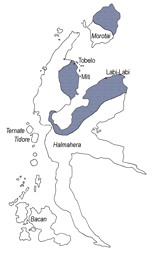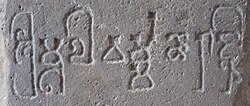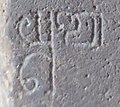The Mentawai language is an Austronesian language, spoken by the Mentawai people of the Mentawai Islands, West Sumatra, Indonesia.

Adityawarman was a king of Malayapura Suvarnabhumi, and is the successor of the Mauli dynasty based on central Sumatra. He was the cousin of Jayanegara, king of Majapahit from 1309–1328, and the grandson of Tribhuwanaraja, king of Melayu Kingdom. Adityawarman was awarded the Senior Minister of Majapahit (wreddamantri) and used this authority to launch Majapahit military expansion plans and conquered east coast region in Sumatra. Adityawarman then founded the royal dynasty of Minangkabau in Pagaruyung and presided over the central Sumatra region to take control of the gold trade between 1347 and 1375.

Tobelo is a North Halmahera language spoken on the eastern Indonesian island of Halmahera and on parts of several neighboring islands. The Tobelo-speaking heartland is in the six administrative districts of Tobelo, located on the western shore of Kao Bay and forming the central part of Halmahera Utara Regency. Other Tobelo-speaking areas are the five districts of Wasile on the southern and eastern shores of Kao Bay, and the northern half of Morotai Island. The district capital, also known as Tobelo, serves as a regional commercial and administrative center and is the largest settlement on Halmahera.

The Pallava script or Pallava Grantha is a Brahmic script named after the Pallava dynasty of South India and is attested to since the 4th century AD. In India, the Pallava script evolved into the Tamil and Grantha script. Pallava also spread to Southeast Asia and evolved into local scripts such as Balinese, Baybayin, Javanese, Kawi, Khmer, Lanna, Lao, Mon–Burmese, New Tai Lue alphabet, Sundanese, and Thai.
Sangirese, also known as Sangihé, Sangi, and Sangih, is an Austronesian language spoken on the islands linking northern Sulawesi, Indonesia, with Mindanao, Philippines by the Sangirese people.

Kutai Kartanegara Regency is a regency of East Kalimantan province, Indonesia. It has a land area of 27,263.10 km2 and a water area of 4,097 km2, geographically located between 1°18′40″S and 116°31′36″E. The population of the regency was 626,286 at the 2010 Census and 729,382 at the 2020 Census; the official estimate as at mid 2021 was 733,626. The town of Tenggarong is the capital of the regency.
Bijdragen tot de Taal-, Land- en Volkenkunde also known by the abbreviated name BKI, is a peer reviewed academic journal on Southeast Asia and Indonesia that was established in 1853 and was published by the Royal Netherlands Institute of Southeast Asian and Caribbean Studies. It was published as Bijdragen tot de taal-, land- en volkenkunde van Nederlandsch-Indië between 1853 and 1948. The journal focuses in particular on linguistics, anthropology, and history of Southeast Asia, and more specifically of Indonesia. It appears quarterly, running a total of roughly 600 pages annually. The editor-in-chief is Freek Colombijn.

Kutai is a historical region in what is now known as East Kalimantan, Indonesia on the island of Borneo and is also the name of the native ethnic group of the region, numbering around 300,000 who have their own language known as the Kutainese language which accompanies their own rich history. Today, the name is preserved in the names of three regencies in East Kalimantan province which are the Kutai Kartanegara Regency, the West Kutai Regency and the East Kutai Regency with the major river flowing in the heart of the region known as the Mahakam River. Kutai is known to be the place of the first and oldest Hindu kingdom to exist in East Indies Archipelago, the Kutai Martadipura Kingdom which was later succeeded by the Muslim Kutai Kartanegara Sultanate.
Daik is the main village (kelurahan) on the island of Lingga of Lingga Regency, in the Riau archipelago in Indonesia. It is located at 0°12′0″N104°37′0″E.

The Tugu inscription is one of the early 5th century Tarumanagara inscriptions discovered in Batutumbuh hamlet, Tugu village, Koja, North Jakarta, in Indonesia. The inscription contains information about hydraulic projects; the irrigation and water drainage project of the Chandrabhaga river by the order of Rajadirajaguru, and also the water project of the Gomati river by the order of King Purnawarman in the 22nd year of his reign. The digging project to straighten and widen the river was conducted in order to avoid flooding in the wet season, and as an irrigation project during the dry season.

Sapeh, also spelt as Sape, Sapeʼ, Sapek, Sapeik, Sapeq, Sampeh, Sampeʼ, Sampek, or Sampeq is the traditional Dayak string instrument of Borneo-origin that commonly developed in northern, eastern, and western of Kalimantan. It is a wooden-base instrument with some simple strings attached, works similar way like the guitar(s).
Tabaru is a North Halmahera language of Indonesia.
Kendayan, or Salako (Selako), is a Malayic Dayak language of Borneo. The exact number of speakers remains unknown, but is estimated to be around 350,000.
A good number of inscriptions written in Sanskrit language have been found in Malaysia and Indonesia. "Early inscriptions written in Indian languages and scripts abound in Southeast Asia. [...] The fact that southern Indian languages didn't travel eastwards along with the script further suggests that the main carriers of ideas from the southeast coast of India to the east - and the main users in Southeast Asia of religious texts written in Sanskrit and Pali - were Southeast Asians themselves. The spread of these north Indian sacred languages thus provides no specific evidence for any movements of South Asian individuals or groups to Southeast Asia.
A Yūpa (यूप), or Yūpastambha, was a Vedic sacrificial pillar used in Ancient India. It is one of the most important elements of the Vedic ritual.

Nicolaus Adriani was a Christian missionary from the Netherlands who did work in Indonesia. He studied linguistics of the East Indies at Leiden University, obtaining his PhD in 1893. He was sent by the Nederlandsch Bijbelgenootschap. He worked as a linguist in Poso, Central Sulawesi.

Kudungga was the founder of the Kutai Martadipura kingdom who ruled around the year 350 AD or 4th century AD. Kudungga first ruled the kingdom of Kutai Martadipura as a community leader or chieftain. Kutai Martadipura during Kudungga rule do not have a regular and systematical system of governance. In contrary, the latest claim is said that Maharaja Kudungga is possibly a king from ancient kingdom Bakulapura in Tebalrung , and Asvavarman which his son-in-law rather his son, then become the first king of Kutai Martadipura.

Kodam VI/Mulawarman is a military territorial command of the Indonesian Army. It has been in active service as the local division for the provinces of North Kalimantan, East Kalimantan and South Kalimantan.
Çri Maharaja Çri Ragajaya was a Balinese king who ruled in the middle of the 12th century CE. The territory of his kingdom most likely covered only the areas north of Lake Batur and East Bali, mainly from Tejakula in Buleleng Regency to Bugbug in Karangasem Regency. The king's name is mentioned on the Tejakula inscription, dated to 1077 Saka. In the inscription, the king appointed the village of Sabhaya to do the jataka for the benefit of a sacred temple, which was named the Bhatara ri Kunjarasana. In return, the villagers were granted various rights for the obligations they had to do.
Yap Goan Ho was a Chinese Indonesian translator, businessman, bookseller, and publisher based in Batavia, Dutch East Indies. In the 1880s and 1890s, he was one of the first Chinese Indonesians to own a printing press and the first to publish Chinese language novels in Malay language translations.















